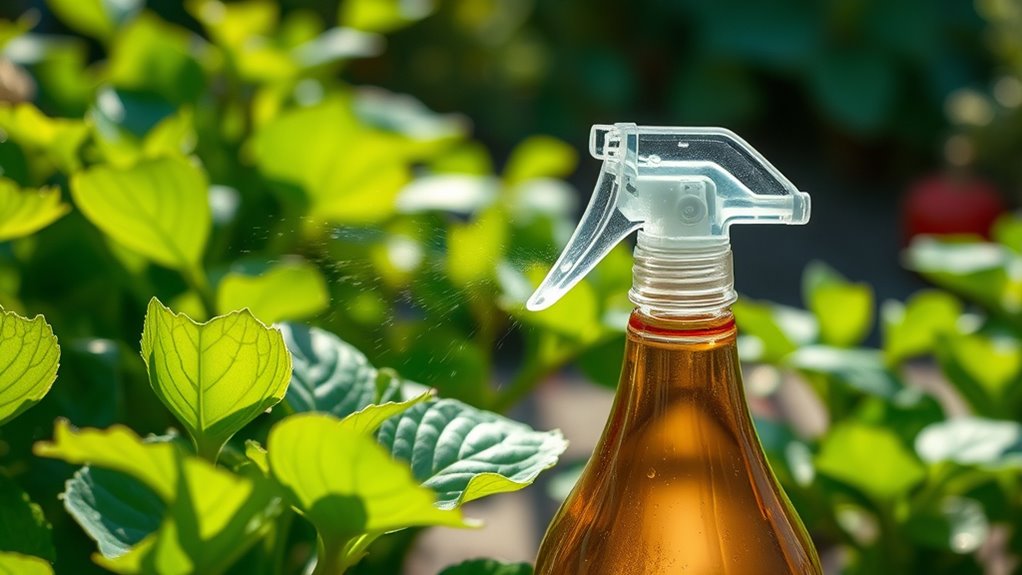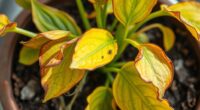To use neem oil safely on your plants, shake the bottle well and mix 1-2 tablespoons with a gallon of water, adding a few drops of mild liquid soap as an emulsifier. Spray thoroughly on all plant surfaces, especially the undersides of leaves, during cooler parts of the day. Apply every 7 to 14 days during infestations, but always follow label instructions. If you want to discover more tips for safe and effective use, keep exploring this guide.
Key Takeaways
- Shake the neem oil container well and mix with water and a mild liquid soap before spraying.
- Spray thoroughly on all plant surfaces, especially undersides of leaves, during early morning or late afternoon.
- Test on a small plant area first to check for adverse reactions before full application.
- Apply every 7 to 14 days during infestations, avoiding extreme heat or rain.
- Follow label instructions for proper dilution and use to ensure plant safety and effective pest control.

Neem oil has become a powerful natural solution for gardeners and homeowners seeking eco-friendly pest control and plant health. If you’re involved in organic gardening, you know that protecting your plants without relying on synthetic chemicals is essential. Garden pests like aphids, spider mites, whiteflies, and scale insects can quickly damage your plants, but neem oil offers a safe, effective way to manage these pests without harming beneficial insects or the environment. Its natural properties make it a popular choice for those committed to sustainable gardening practices.
Using neem oil correctly is key to maximizing its benefits while avoiding potential harm to your plants. Before applying, always shake the container well to ensure the oil is evenly distributed. Mix the neem oil with water and a small amount of mild liquid soap, which acts as an emulsifier, helping the oil blend smoothly. Typical dilution rates are about one to two tablespoons of neem oil per gallon of water, but check the product label for specific instructions. Spray the mixture thoroughly on all plant surfaces, paying special attention to the undersides of leaves where pests often hide. Regular applications every 7 to 14 days can help keep pests under control, especially during peak infestations.
Neem oil works primarily by disrupting the feeding and reproductive cycles of garden pests, making it an effective tool in your organic gardening arsenal. When pests attempt to feed on your plants, the neem oil interferes with their hormonal systems, preventing them from maturing or reproducing. This not only reduces pest populations but also minimizes the need for repeated applications over time. Keep in mind that neem oil is most effective when applied early in an infestation, so regular monitoring of your plants is essential. It’s also important to apply neem oil during cooler parts of the day, such as early morning or late afternoon, to prevent leaf burn and maximize absorption. Additionally, choosing a Vetted product ensures you get a reliable and effective formulation for your gardening needs.
While neem oil is generally safe for most plants and beneficial insects, it’s wise to test it on a small area first to watch for any adverse reactions. Avoid applying neem oil during extreme heat or when rain is forecasted, as this can wash away the treatment or cause leaf damage. Proper timing and application techniques ensure that you’re protecting your organic garden efficiently and safely. Overall, neem oil is a versatile, eco-friendly option that helps you maintain healthy plants and manage pests effectively, aligning perfectly with your commitment to organic gardening.
Frequently Asked Questions
Can Neem Oil Be Used on All Types of Plants Safely?
You might wonder if neem oil is safe for all plants. While it’s effective against pests, plant sensitivity varies. Some plants, like succulents or azaleas, may react negatively, causing leaf burn or stress. Always test neem oil on a small area first. If your plant shows sensitivity, consider neem oil alternatives like insecticidal soaps or horticultural oils. This way, you protect your plants without risking damage.
How Often Should I Apply Neem Oil to My Plants?
You should consider your plant’s sensitivity when deciding on application frequency. Generally, applying neem oil once every 7 to 14 days works well for most plants. If your plants are more sensitive, reduce the frequency to once every 10 to 14 days. Always observe your plants closely and adjust the application frequency if you notice any signs of stress or leaf damage. Regular but cautious use guarantees safe and effective pest control.
Is Neem Oil Effective Against All Pests and Diseases?
Think of neem oil efficacy like a Swiss Army knife—versatile but not a cure-all. It works well against many pests and diseases, but some pests develop resistance over time. You shouldn’t expect neem oil to be effective against all pests and diseases. Regular application helps maintain its effectiveness, but for resistant pests, combining neem oil with other methods boosts your chances of protecting your plants effectively.
Can Neem Oil Harm Beneficial Insects?
You might wonder if neem oil harms beneficial insects. While neem oil is generally safe and promotes beneficial insect safety, it can pose some neem oil toxicity risks if applied excessively or at the wrong time. To protect helpful insects like bees and ladybugs, apply neem oil early in the morning or late in the evening when they’re less active. Always follow label instructions to minimize harm and maximize pest control.
What Should I Do if My Plants Show Signs of Neem Oil Damage?
Like a firefighter dousing flames, you need to act quickly. If your plants show signs of neem oil damage, assess their plant sensitivity and remove affected leaves gently. Rinse the plants with water to reduce further damage and improve damage mitigation. Avoid applying neem oil again until your plants recover. Keep an eye on them, and consider diluting the oil more next time to prevent future issues.
Conclusion
As you wield neem oil like a gentle guardian, remember it’s your shield against pests and disease. Think of it as a nurturing rain, nourishing your plants’ health while keeping harmful invaders at bay. By using it wisely, you’re planting seeds of harmony and resilience in your garden’s story. Embrace this natural ally, and watch your plants flourish like a vibrant tapestry—each leaf a brushstroke in your thriving, lush masterpiece.









